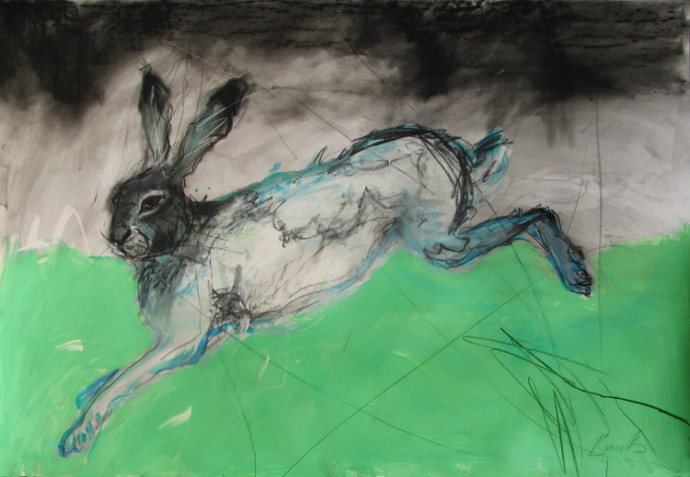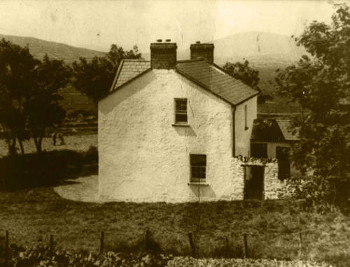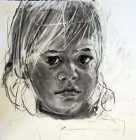



"Crow Voice, Fox Voice....Wolf Voice" , a solo exhibition from Margo Banks at the Solomon Gallery, Balfe Street, Dublin 2 from 29th June 2023. The show will be officially opened by Jessica Traynor, Poet. Please see a selection of images below.
In Margo's work we see her love for the wildlife of Kerry. Using contemporary art methods she depicts what she has seen in the Kerry mountains since she was a child. From images of hares jousting, and crows surveying, to wasps congregating, Margo captures the wonders of nature as she experiences them.
In a recent piece reviewing Margo's work Niall MacMonagle, in the Irish Independent, describes her work as
painting is to live the dream. Kerry sheep, bumble bees, seagulls... and first, catch your hare. That she's done. Right here.You can read his piece here which reviews a recent work entitled "Chasing the Wind II" shown below.

 If John B. Keane’s great 1965 play, The Field, is a parable of atavistic landlust and communal corruption, there is another Kerry field, up Teeromoyle mountain on the Iveragh Peninsula, which is attuned to another kind of memory. For Margo Banks, it’s the seat of her near-ancestors, their traces mysteriously vanished from within a walled meadow; like a secret garden in the remote, scraggy townland of Thoon.
If John B. Keane’s great 1965 play, The Field, is a parable of atavistic landlust and communal corruption, there is another Kerry field, up Teeromoyle mountain on the Iveragh Peninsula, which is attuned to another kind of memory. For Margo Banks, it’s the seat of her near-ancestors, their traces mysteriously vanished from within a walled meadow; like a secret garden in the remote, scraggy townland of Thoon.
Mining a web of long-cherished, dwindling family connections to the district, Banks has increasingly tethered the thinking behind her work to this vacant plot of ground. Here once stood the house where her mother Kathleen Josephine Barry (Caitlín Seosaimhín de Barra) grew up: the youngest of thirteen born to Cornelius Barry and Ellen O’Sullivan, headmasters of the two-room schoolhouse across the road. The schoolhouse has long slumped into dereliction; yet, within the walled garden, there is no sign of the once-substantial family home.
Though largely self-taught, Banks is an assured, accomplished draughtsperson, painter and sculptor. She works rapidly and loosely at the big, boisterous drawings which are the cornerstones of her work; many depicting certain totemic animals of those hillsides. She has a keenly observed mastery of form, using a muscular shorthand to pin down telling essentials of anatomical detail: the strange ungainly bone-structures of cattle and goats; the kinetically jointed skulls of her ever-popular, blunt-nosed hares. These she overlays with an impatient blizzard of strokes, swipes, smudges, hatchings, scribble-explosions and wildly inscribed fragments of poetry. The effect is of peculiar force and blurred animation; topped with restless scrubs and sprays of outlandish colour which are yet somehow perfectly apposite.
Her bleak, depopulated bogscape drawings similarly seethe with evocative movement, the charcoal rhythmically erased to form lines or blooms of white, like unmoored ancient field patterns; her frenetic over-squiggles conjuring bog-cottons, grasses, rainflecks: torn this way and that in the upland winds.
 Certain themes she bring to paintings on canvas: far more layered, labour-intensive compositions, which Banks pushes into spindrifts of light and warm, organic pigments; floral violences of motion and colour; or brooding, high-horizoned fieldscapes reminiscent of Hughie O’Donoghue. Some take flight into pure abstraction; like Icicle of Moonlight (the title borrowed from Lorca), its diaphanous cruciform detonating against a benighted abyss. Taking her motif of the papery comb of a wasps’ nest, she dissolves it in a time-lapse haze of cerulean turquoise; while her talismanic hare in The Edge of That Water, like an escapee from the old Irish thruppence coin, has a hind foot mysteriously set aflame.
Certain themes she bring to paintings on canvas: far more layered, labour-intensive compositions, which Banks pushes into spindrifts of light and warm, organic pigments; floral violences of motion and colour; or brooding, high-horizoned fieldscapes reminiscent of Hughie O’Donoghue. Some take flight into pure abstraction; like Icicle of Moonlight (the title borrowed from Lorca), its diaphanous cruciform detonating against a benighted abyss. Taking her motif of the papery comb of a wasps’ nest, she dissolves it in a time-lapse haze of cerulean turquoise; while her talismanic hare in The Edge of That Water, like an escapee from the old Irish thruppence coin, has a hind foot mysteriously set aflame.
There is nothing particularly cute or sentimental about Banks’ ‘beasts of the field’: they shimmer and abound with edgy character; with an elemental, almost mythic aspect. Her signature hares, based on the Irish subspecies, Lepus timidus hibernicus, are pookas of a kind. Glowering, startled or pensive, they dance, skip, careen on their springloaded hind limbs, or simply squat, sphinx-like; garlanded with washes of green, tawny-orange or wild pinks; their pared nerves evident in their 360-degree, prey animal’s vision, wrapped around their narrow skulls. The sharpest focus is often on the eyes, amidst a haze of marks and depth effects, as with the oddly titled, Feeling Secure, its hare sitting out a gloaming snowstorm.
In Ireland as elsewhere, hares are mythologised as otherworld beings, from the legend of Oisin to centuries-old spooktales of wounded hares chased to ground, only to find crones or princesses bleeding from leg wounds; as witches in disguise suckling cows in the fields at night; or their banshee associations, thanks to their piercing distress-cry. One pisreog was reported from Kerry in 1893: that the country people wouldn’t eat hares, believing their grandmothers’ souls had entered into them. As Banks says:
“They just have this otherness about them. They share the world with us, but they don’t seem really aware of us.”
Banks’ crows are another archetype: strutting cocks of the walk or squawking skybursts of carpal feathers: hooded crows, carrion crows, daws, choughs - beady-eyed imps of fiendish cleverality. Banks seems to relish their gallows associations, their undertaker’s plumage, their reputation as ill-omens. Her ragged-trousered rooks, with their brute, bone-cruncher beaks remind one of the corpse-hungry scaldcrows of Irish mythology, as in Morrigan’s Ravens, Banks’ public bronze piece in Dundalk: a colloquy of three bickersome crows atop a standing stone, with a nod to the dying Cúchulainn (although, unlike Oliver Sheppard’s iconic sculpture, the sacrificial male form is absent).
Back in the field, Banks’ long-horned puck goats roam; or equally native to those parts, the black Kerry cows, a smallish, hardy ancient breed (the eighth-century Irish law-text, Bretha Nemed Toísech talks of milch cows “as black as blackbirds”). Again, Banks depicts them with blunt physicality; in the painting, Teeromoyle Cattle, rendered in strange, floating planes on the canvas, like something from the Lascaux caves.
Banks’ wolves typically skulk, furtively into frame. They cower warily: mostly alpha she-wolves, lean and ravening, with matted pelts and raw-looking teats; like the she-wolf who suckled Romulus and Remus. For Banks, these are something of a self-symbol, marking the arduous years of rearing her three boys alone. Long-extinct in Ireland, demonised as far back as the Book of Kells, the last wolf reported in Ireland was a female shot in County Carlow in 1786 - wiped out, seed and breed.
 The autobiographical strain in Banks’ work stems from tales her mother spun on long ago summer holidays to Ballinskelligs and Caherciveen, with its sacred mountain, Cnoc na dTobar, and the derelict skull of the Famine-era workhouse out the road. But more sacred to memory were the drives up to Teeromoyle and the field-garden of her mother’s childhood. Even then, the house was long gone; and only a few panda-faced sheep haunted the place. Banks has one 1930s photograph of the fine two-story house with its tiled roof and walled back yard; the misted hills beyond; and in the next field, a man picturesquely tossing hay. But only the perimeter drystone walls now remain, overgrown by trees and hedgerow life. Banks returns there often, to sketch and walk the field, searching for vestiges of the house, yet other than vague lumps in the shaggy terrain, she finds nothing. Instead, the field is a sort of time-machine: sometimes joyous, sometimes oppressive; veined with tragedy and shadows from harsher times. Taking her sketches back to the studio, its moods infect her. She has said:
The autobiographical strain in Banks’ work stems from tales her mother spun on long ago summer holidays to Ballinskelligs and Caherciveen, with its sacred mountain, Cnoc na dTobar, and the derelict skull of the Famine-era workhouse out the road. But more sacred to memory were the drives up to Teeromoyle and the field-garden of her mother’s childhood. Even then, the house was long gone; and only a few panda-faced sheep haunted the place. Banks has one 1930s photograph of the fine two-story house with its tiled roof and walled back yard; the misted hills beyond; and in the next field, a man picturesquely tossing hay. But only the perimeter drystone walls now remain, overgrown by trees and hedgerow life. Banks returns there often, to sketch and walk the field, searching for vestiges of the house, yet other than vague lumps in the shaggy terrain, she finds nothing. Instead, the field is a sort of time-machine: sometimes joyous, sometimes oppressive; veined with tragedy and shadows from harsher times. Taking her sketches back to the studio, its moods infect her. She has said:
“Painting the field sometimes makes me feel snug, warm and sheltered; and other times exposed, vulnerable and turbulent.”
 Using her mother’s stories to fill out archival traces, Banks found the family in the 1911 census: Cornelius (32) and Ellen (31), four of their sons, one new-born; and daughter Eileen: all literate Roman Catholics, English- and native Irish-speakers; with a domestic servant and the first Model T Ford in the locality. But the mortality that ripped through them was appalling. In the old School Register, Banks found her mother, Kathleen; and the deaths of two of her siblings, succinctly noted in Banks’ grandparents’ own handwriting. Cornelius Laurence (7) died in 1908 from “burning” (after setting fire to his bed with matches); Patrick Francis (6) in 1912 (after falling into a boiling pot of animal feed). Later, Eileen worked as a nurse in England, where she contracted TB and came home to die in 1923, taking five more siblings with her – leaving only five alive from a brood of thirteen. In 1938, Cornelius Senior dropped dead in the kitchen; and in 1943, Ellen died from smoke inhalation after the Harp hotel fire in Caherciveen; particularly agonising for Kathleen as, with her new civil service wages, she had treated her mother to the stay.
Using her mother’s stories to fill out archival traces, Banks found the family in the 1911 census: Cornelius (32) and Ellen (31), four of their sons, one new-born; and daughter Eileen: all literate Roman Catholics, English- and native Irish-speakers; with a domestic servant and the first Model T Ford in the locality. But the mortality that ripped through them was appalling. In the old School Register, Banks found her mother, Kathleen; and the deaths of two of her siblings, succinctly noted in Banks’ grandparents’ own handwriting. Cornelius Laurence (7) died in 1908 from “burning” (after setting fire to his bed with matches); Patrick Francis (6) in 1912 (after falling into a boiling pot of animal feed). Later, Eileen worked as a nurse in England, where she contracted TB and came home to die in 1923, taking five more siblings with her – leaving only five alive from a brood of thirteen. In 1938, Cornelius Senior dropped dead in the kitchen; and in 1943, Ellen died from smoke inhalation after the Harp hotel fire in Caherciveen; particularly agonising for Kathleen as, with her new civil service wages, she had treated her mother to the stay.
Most people in Teeromoyle are elderly now, yet nobody remembers how such a substantial house as the Barry’s disappeared. A neighbouring farmer still grazes animals there, but it now seems no one owns the field.
 Banks still lives in her own childhood home, in Clontarf, under the big-dome sky of Dublin Bay, where she has painted many lambent canvases. Born in 1951, she was artistic from early on and, at 13, started oil painting classes. A rebel child, she decamped to Spain in 1968; met her late husband, Miguel, the son of a gypsy; and had their three sons. In 1980, Banks’ father died suddenly; then in 1982, her mother was diagnosed with cancer, and Banks came home to nurse her. One day, the mother sat her down, handed over her wedding ring, and said, “now, I will tell you the story of my life”. And so she did, in her storytelling way, confiding to Margo that after her own mother died (when she was only 23), she had always longed for a daughter to somehow replace her (as she faded to a wisp, her last word was “Mama”). Through this vertigo of living bereavement, Banks feels she didn’t retain much of what her mother said, and cannot now remember the sound of her voice.
Banks still lives in her own childhood home, in Clontarf, under the big-dome sky of Dublin Bay, where she has painted many lambent canvases. Born in 1951, she was artistic from early on and, at 13, started oil painting classes. A rebel child, she decamped to Spain in 1968; met her late husband, Miguel, the son of a gypsy; and had their three sons. In 1980, Banks’ father died suddenly; then in 1982, her mother was diagnosed with cancer, and Banks came home to nurse her. One day, the mother sat her down, handed over her wedding ring, and said, “now, I will tell you the story of my life”. And so she did, in her storytelling way, confiding to Margo that after her own mother died (when she was only 23), she had always longed for a daughter to somehow replace her (as she faded to a wisp, her last word was “Mama”). Through this vertigo of living bereavement, Banks feels she didn’t retain much of what her mother said, and cannot now remember the sound of her voice.
In 1983, Banks returned full-time to Clontarf with her three young cubs; working late into the evenings on her art. She began working in ceramics, built a kiln in the garage; moving onto bronze sculpture, before returning to drawing and painting. With each medium, she enjoyed early success, and has shown for many years at the Royal Hibernian Academy and Royal Ulster Academy; amongst many solo shows. Her work now sits in private collections across Ireland, the UK and Holland, as well as the OPW, Enterprise Ireland and Cill Rialaig.
The walls of her bright, airy house groan with her paintings, hung salon-style up- and downstairs. The garden is dotted with flame-flowered Montbretia transplanted from Kerry, whilst old ceramic figures lurk amongst the rockeries - fay, faun-like nudes, many modelled on her young sons; or, indoors, the impressive seated woman, the melancholy well of her skirts scaffolded by the long etiolated limbs.
 A garrulous, unguarded, bighearted woman, Banks welcomed me in one day as she was training binoculars down the long back garden where she has seen “buckets of badgers” and foxes. To my astonishment, a grey squirrel was clambering among the bird-feeders. Out front, from her studio, I spied her panoplies of crows, squabbling in the trees. Around her easel lay a jumble of drawings and paint- and charcoal-smudged books: and her two big drawing cabinets, one filling the space of the bed in which her mother died, aged 62, when Banks was 30. Notwithstanding Banks’ fierce love for her sons, she too longed for a daughter, and was beyond ecstasy when her son Daniel’s partner Jenny delivered her a granddaughter, Juno: a big-eyed, strong-willed girl, whom Banks has often, exquisitely sketched.
A garrulous, unguarded, bighearted woman, Banks welcomed me in one day as she was training binoculars down the long back garden where she has seen “buckets of badgers” and foxes. To my astonishment, a grey squirrel was clambering among the bird-feeders. Out front, from her studio, I spied her panoplies of crows, squabbling in the trees. Around her easel lay a jumble of drawings and paint- and charcoal-smudged books: and her two big drawing cabinets, one filling the space of the bed in which her mother died, aged 62, when Banks was 30. Notwithstanding Banks’ fierce love for her sons, she too longed for a daughter, and was beyond ecstasy when her son Daniel’s partner Jenny delivered her a granddaughter, Juno: a big-eyed, strong-willed girl, whom Banks has often, exquisitely sketched.
Banks now imports her mother’s image into the work, based on the few mottled old photos of her: as a near-toddler; a teenager, the big, open, strong-boned face framed by her floss of dark hair; or as a glamorous, quiffed young woman, sitting on a Kerry wall in neat-cut jacket and blouse - her blazingly guarded gaze truly resembling Banks. So far, Banks has depicted her mother as a child – as the youngest of her family, always the “dotey”. In one recent drawing, she spectrally hovers over a phantom orchard; in others, Banks fancies that she had a pet crow, which perches on her head; or allows her to clutch its dark wings to her ears, as if to muffle out the world’s turmoil. One painting, The Stolen Child, is macabre: her mother’s face above a doll-like child’s body; traversing a watery boundary into the dark side, reaching back through handwritten lines from Yeats’ poem of faerieworld abduction.
Apart from Banks’ sheer joy in image-making, somewhere in that long-numbed loss, that sense of love, longing and belonging, lies the impetus behind her work. She claims to be at a loss to explain or rationalise her rawly instinctive method (sometimes even painting with her eyes closed), other than to say that she often works “without rhyme or reason”.